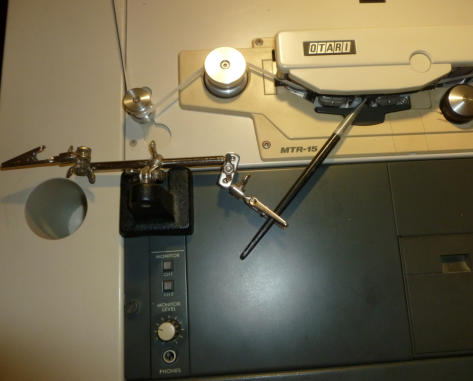

Corey Bailey
Audio Engineering
USEFUL INFORMATION
MOISTURIZING ACETATE BACKED TAPE
Encountering an acetate base tape that has been stored for several years will
almost guarantee problems. If acetate base tape has been kept in a moist
environment, mold and/or vinegar syndrome will probably be the case and you
should be reading some of my other articles on that subject.
This article is about acetate tapes that have been kept where it is dry.
Cupping is a common problem with acetate base tapes that have been stored for
a long time in dry conditions. The tape itself looks like the shape of a metal
Venetian blind. As a result, winding problems can occur. In extreme cases, the
oxide that holds the audio will come loose and fall off of the acetate base.
Most of the problems are caused by the tape losing moisture over time.
Here are some remedies that have worked for me;
Method #1
Place some moistened (damp, not wet) cotton balls in the corners of the box with
the tape. I use distilled water for moistening the cotton. Make sure that the
moistened cotton does not touch the tape and leave it overnight. Upon checking
the tape, look for how much moisture has been absorbed from the cotton.
Inspect a couple of layers of the tape. If progress is being made, repeat as many
as 2 or 3 times leaving the tape with the moistened cotton for 24 hours or so.
Moisten the cotton each time. If this method dose not work, then try #2 or #3.
Method #2
This involves building a closed system whereby the tape is suspended over water.
I used a portable BBQ (Tailgate type) that was cheap and it included a lid that fit
well. After sealing the pan area, place the tapes on the grille with some distilled
water in the sealed area where the coals normally go. You can leave the tape(s)
in this environment for weeks or months if necessary so, be sure that all of the
water doesn’t evaporate. You can turn the tapes every few days (optional) when
you check the progress. In my situation, the process took about 3 to 4 weeks as I
recall. It was long enough that the barbecue pan began to rust and I threw the
whole thing out when done. The tapes however, were playable.
I’ve heard from people that have used plastic storage containers or large kitchen
cookware steamers for hydrating acetate base tapes. In fact, I’ve been keeping
an eye out for just such a large steamer at the local thrift stores so that I can add
it to my stash of ‘I will need this someday’ items.
Method #3
If the tape is not badly cupped, wind the tape inside out (B wind). To do this,
simply put a twist in the tape while winding from one reel to another. The result
will be oxide out. Use a slotless hub reel if you have one. Otherwise, attach some
leader to the end of the tape so that the leader acts as a buffer against the slotted
hub. While you are at it, attach some leader to the head end of the tape so that it
protects the outer wraps. Avoid the (stationary) lifters on your tape deck and wind
the tape directly from one reel to the other. Use one hand to control the winding
speed and tape tension. Protecting the speed and tension control hand with some
cloth or a cotton glove is necessary when winding directly from one reel to
another. While a ‘B’ wind can neutralize some of the deformity that is encountered
with acetate tape that has been stored for a long time, be mindful of the oxide at
all times. This method will put more stress on the oxide layer. So, if the
cupping is severe, this method could loosen the oxide and cause flaking and
should not be used. If the oxide falls off, it’s game over! This method
takes, at least, three months or longer and can be used by itself or combined with
methods 1 or 2 if you wish.
It took a long time for the tape to become deformed in the first place, so it will take
some time to reverse the situation. Sometimes this method will work better than
humidification and sometimes this method works best in conjunction with process
1 or 2. It all depends on the condition of the tape.
I have only used method #3 a few times because customers usually did not want
to wait for the time it can take. As such, I usually had to warn them that the
returned tape may not be wound as smoothly as when it was delivered.
TRANSFERRING WARPED TAPE
Head contact is a real problem with warped or cupped tapes so, I will add some
extra pressure to the play head to help the situation (Yes, this will increase head
wear). I use an artist paint brush for this process. I also use ‘Helping Hands’
alligator clips to keep a constant pressure and so that I don’t have to hold the
brush for the duration of the reel.
Fig. 1; ‘Helping Hands’
Fig. 2; Positioning of the tension brush
Return to TOP of page
© Corey Bailey Audio Engineering
DO IT YOURSELF?
ANALOG TAPE
BAKING AUDIO TAPE
LUBRICATING AUDIO TAPE
MOISTURIZING ACETATE
TAPE
RECORDS (DISCS)
RECORD CLEANING
REPAIRING A BROKEN 78
FLATTENING A RECORD
ARTICLES
A Little About Sound
Bit Depth
Conductive Paint
Mold
Optimizing your PC
Packing Records for Shipment
People I have Known
Playing Records Wet
Playing a Wire Recording
Sample Frequency
Saving Your Family Video
The Alley
The Internet
The Ken Slater Tapes
Time Charts
Transfer Stories
Tubes vs Transistors
What Type of Wire?
Your Digital Data is at Risk











